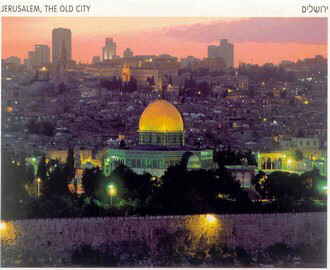 Alon K. Raab
Alon K. RaabHowever, Semmerling’s analyses of specific cards are not always convincing. In one Israeli card, “Come, Join me in Ein Gedi,” a woman wearing nothing more than a tiny shirt and high heels, her behind exposed, is interpreted by Semmerling as “the Israeli national self, denoted by this woman, is presented to the viewer as beautiful, sexy, and erotic. The postcard encourages the viewer to partake in the benefits of Israel’s ‘scenery’ and to idolize the new Hebrew as a beautiful being.” An alternate reading might be that she is an immodest tourist and, judging by her attempt to walk the desert in high heels, not too bright.
While focusing on a few images in depth has its merit, an
accompanying statistical analysis of a much larger sample would
have been illuminating. Choosing Palphot as the sole representative
of the Israeli outlook has its drawbacks. Semmerling selected the
company because of its long dominance of the Israeli market (though
the figures he cites are company claims from two decades ago), but
its gigantic output is not as uniform as he would have us believe.
 For example, along with Palphot images that diminish the importance of the Temple Mount/Haram al-Sharif mosques, there are also cards where these monuments appear in all their splendor as the focal point. And while it is true that the portrayal of Masada has often centered on images of war and death with their possible contemporary implications, many other Masada cards emphasize its natural beauty.
For example, along with Palphot images that diminish the importance of the Temple Mount/Haram al-Sharif mosques, there are also cards where these monuments appear in all their splendor as the focal point. And while it is true that the portrayal of Masada has often centered on images of war and death with their possible contemporary implications, many other Masada cards emphasize its natural beauty.
Furthermore, Semmerling ignores all other Israeli card companies and the work of individual artists, creating a false image of a nation ruled by a monolithic ideology. Jewish society was always comprised of competing groups and belief systems. Palphot founder Tova Dorfzaun’s statement that when she arrived in the country in 1934, “there was so little here to photograph” does indeed echo a popular Zionist conception about the desolation of the land. But this is hardly the only Zionist narrative. There have always been individuals such as Ahad Ha-am, Yitzhak Epstein, Martin Buber and Judah Magnes, as well as various peace groups that recognized the Palestinian people and their rights, and artists who have reflected those concerns. Semmerling quotes several of the post-Zionist writers and their cutting analysis of Israeli society, but does not give sufficient weight to the massive changes in Israeli individual and collective consciousness that have taken place since the 1967 war and have gathered speed since the peace efforts of the early 1990s. While Semmerling does not claim to address all ways that Israelis have looked at themselves and at the “Other,” his decision to lump all Israeli cards in one chapter, and selectively read the output of a single postcard company gives the impression that there is a singular Israeli awareness and perspective. This is a misleading view, which such books as David Ohana’s “Myths and Memory-Transfigurations of Israeli Consciousness” and Rubik Rozental’s “The Inner Split” would have put to rest.

Finally, Semmerling focuses only on the differences between the two people’s representations, leaving out obvious parallels. Many symbols and images Palestinians currently employ, such as the glorification of the farmer or the importance of the olive tree, mirror ones that Jews embraced while under British and Ottoman rule, and the enthusiastic response of Palestinian exiles to the homeland photos of Ziad Izzad has its equivalence in the way Diaspora Jews yearned for images of their homeland. Semmerling shows the deep connection Palestinians feel to the land’s flora and fauna, but ignores the many Palphot cards echoing this, as well as cards by private and governmental Israeli nature organizations. The book would have been strengthened by acknowledging such connections, perhaps even tracing the history of how certain images from one side of the conflict became adopted by the other.
Of course, in any writing about such a loaded subject, the question of objectivity is always raised, and Semmerling occasionally does provide balance. He uses sources by writers of conflicting stripes, from the nationalistic Shmuel Katz to the anti-Zionist Ella Shohat. And while a major part of his criticism is directed at Israeli blindness and callousness, he also shows weakness in Palestinian representations: the nostalgic emphasis on farming life, ignoring social and economic divisions and most evidence of modernization; the way the representation of victimization absolves Palestinians of responsibility for their fate; and the denial of Israelis’ humanity.
In his concluding chapter, Semmerling refers to the hot air balloon journey of Mark Twain’s Tom Sawyer, Huck Finn and Jim, with Tom functioning as “a visual methodologist” who connects what he sees from up high with the imagery of maps. This fools Tom into believing that he is still over Illinois, since he did not see the tell-tale pink-colored state of Indiana. Israel's borders are a bit more absolute: the "green line" is indeed green, and visible from space; and the Israeli separation wall is unmistakable. Still, Semmerling hopes we can all descend from our balloon and see things not as political semioticians, tourists, or propagandists, but from the perspective of those living on the ground. His book is a flawed but valuable step in that direction.

Before the fall
August, 2005
August, 2005
July, 2005
How I learned to stop worrying and write a novel about Israel
February, 2005
Artists on 9/11 and the war on/of terror
October, 2004
Catching up with some famous refugees
May, 2004
Is Zionism Colonialism?
June, 2003



Sephardic Literature: The Real Hidden Legacy
David Shasha
plus Jordan Elgrably on the Sephardic Intellectual
Guilt and Groundedness
Jay Michaelson
David: The Original Drama King
Dan Friedman
The Doctor
Sarah Schulman
After sepia photographs
Hila Ratzabi
A War in Postcards
Alon K. Raab
Archive
Our 760 Back Pages
Zeek in Print
Summer 2005 issue now on sale
About Zeek
Mailing List
Contact Us
Subscribe
Tech Support
Links
Limited Time Offer
Two years of Zeek in
print for only $20.
Offer expires 9/30.
Click this button
to purchase:
From previous issues:
Quality of Life
Hipster Antisemitism
James Lee Byars and the Number Ten
Jay Michaelson
Jennifer Blowdryer & Alvin Orloff
Abi Cohen
 Email us your comments
Email us your comments